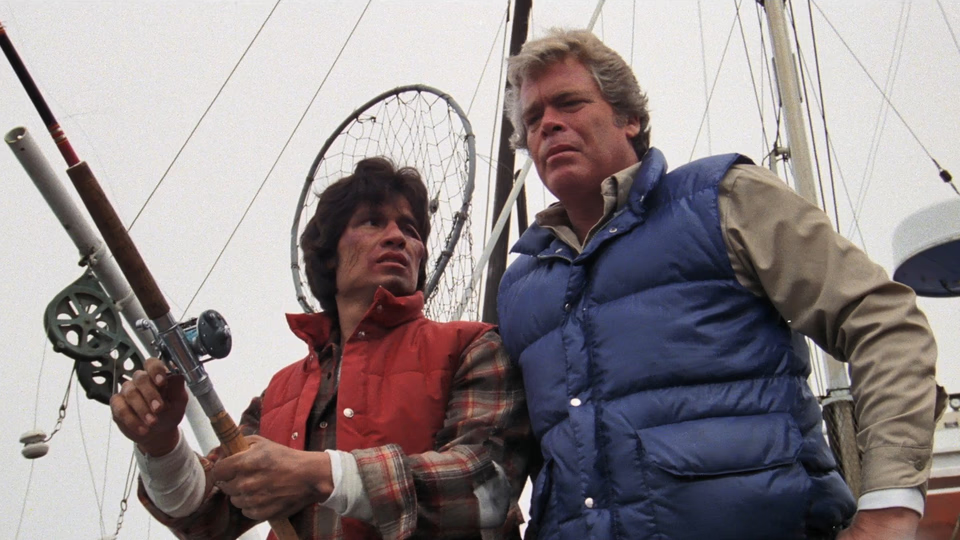Humanoids from the Deep

Delicate sensibilities beware. Humanoids from the Deep features explicit rape sequences, a graphic dog killing, and multiple mutilated dog corpses. But those that brave a viewing will discover a thrilling—albeit often ridiculous—monster movie.
Minutes in, and we have a sense of the film’s world. A small Northern California fishing town. Buildings and boats wear their age, sporting peeling paint and rust, just as years of salt-air and harsh sun have weathered the fishermen.
The town’s economy depends on the dwindling salmon catch. A big corporation wants to build a cannery, promising jobs and increased yields. Vic Morrow plays Hank, a fisherman leading support for the cannery. Opposing Hank, Anthony Pena plays Johnny, a young Native American seeking to return the proposed site to his tribe’s control. This disagreement bubbles Hank’s racism to the surface.
Caught between is Jim, a fisherman played by Doug McClure, who supports the cannery because he believes it will save the town, but can understand Johnny’s side of the argument and harbors no racist feelings.
The film doesn’t address these big-picture issues. They exist to define the characters and enhance the atmosphere. Instead, the film focuses on the monsters. First presenting a POV shot from a creature caught in a trawler’s net. We see a webbed hand and hear its inhuman grunting.
This sequence proffers the first hint of the film’s penchant for explosions. In a cavalcade of ineptitude, the trawler’s crew spill a gasoline can, drenching the deck floor. Despite the overwhelming odor, the first mate then discharges a flare gun into the floor. The ship explodes in a mushroom cloud, raining debris. The creatures are horrible, sure, but this is the crew’s fault.
Speaking of the creatures, later that night we get our more glimpses. An arm and shadowed face as they venture ashore and murder the aforementioned dogs.
Then the film missteps.
It’s not that I found the rape sequences unnecessary. They add a visceral edge while remaining brief enough to resonate, but not so long that it feels like the film is rubbing our nose in them. But the decision to film the first one in broad daylight disappoints. The scene provides our first look at the creature. It looks like a man in a dry, ill-fitting rubber suit. The harsh lighting doesn’t help.
This surprises, given how much better the monsters look in later scenes, where shadows and copious mucus hide the seams and offer a more organic appearance. Then you learn producer Roger Corman added the rape scenes during post-production, filmed by Jim Murakami1, likely without creature designer Rob Bottin’s input or even awareness.
But back to the movie. Hank decides Johnny is behind the dog deaths and picks a fight during a town dance. When Jim intervenes on Johnny’s behalf, Hank and his gang setout the following night under cover of darkness to torch Johnny’s isolated riverside cabin.
The men coast up and toss a Molotov cocktail. Another giant explosion. Debris rain down and what’s left of the cabin burns. Hank and his crew flee, while Johnny finds himself attacked by the creatures as he tries to extinguish the flames.
One of Johnny’s guests heads out in a battered pickup for aid, but finds herself ambushed by the creatures. She drives off a bridge and—you guessed it—explosion.
Considering Bottin’s landmark work on The Thing two years later, one wishes some of the explosion budget would have gone to his department.
But I digress. The creature attacks escalate, and the town soon learns some shady science might be behind the creatures and their desire to prey upon the town’s women. Everything culminates with a terrific sequence staged during a town carnival where masses of creatures erupt through the boardwalk and attack the townsfolk in a bloody massacre.
At eighty minutes, the film moves fast. It doesn’t wrap up its plot threads, it just ends, proffering a sense the town has won a battle at a shocking cost but the war still looms. Perhaps this was producer Roger Corman leaving the door open for a potential sequel, or paring down the script for budgetary reasons, but the result only adds to the film’s verisimilitude and resonant horror. Life doesn’t offer neat endings. Chaos happens, leaving you to pick up the pieces.
Notes
-
Lukeman, Adam. Fangoria’s 101 Best Horror Movies You’ve Never Seen: A Celebration of the World’s Most Unheralded Fright Flicks. United Kingdom: Crown, 2011. ↩︎